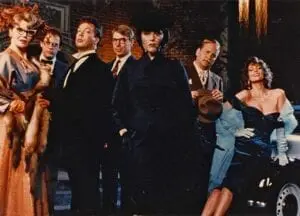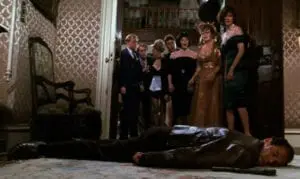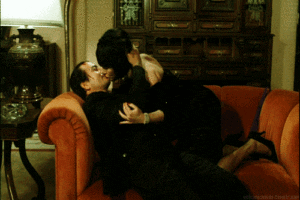Clue
"It's not just a game anymore."
(1985)
starring Eileen Brennan, Colleen Camp, Tim Curry, Madeline Khan, Christopher Lloyd, Michael McKean, Martin Mull & Lesley Ann Warren
PODCAST:
'80s Movies: A Guide to What's Wrong with Your Parents -
CLUE: Sexual Stereotypes were helpful to No Boddy
Why it’s rad:
- Every kid grew up playing this whodunit board game.
- Full of quotable lines.
- The film features some of the finest comedic actors of the era.
So '80s:
As the film is set in the '50s, there's nothing distinctly '80s about it except for the nonstop sexual innuendo. However, it could also be noted that this may be the film's failure at the box office marks the line where moviegoers preference for comedy had changed. The comedy is vaudevillian and jokey, the kind where you might expect to hear the "ba-da-bum" after the punchline. Comedy was changing in the mid-'80s: while the bawdiness was still in play, the slapstick one-liner comedy was being left behind for relatable, situational comedy (Leslie Nielsen-style sight gag humor like Airplane! and The Naked Gun was its own '80s genre - and Clue does reflect some of these influences).
What’s your damage?
While this is depicting the 1950s, some of the attitudes are distinctly from the '80s.
-
Every attractive woman's value is through sex. Both Miss Scarlett and Yvette work in the sex trade; they wear low-cut attire that exposes a good portion of their breasts. Ms. White is made to look less appealing with a severe haircut, but nonetheless, is a Black Widow type -- she lures men in with her sexuality and then kills them. In contrast, Mrs. Peacock is made to be completely unattractive and, thus, commits a crime that's unrelated to sexuality (she takes bribes for her husband, a Senator).
-
Homosexuality is unacceptable. So, given that this takes place in the 1950s, it is historically accurate that Mr. Green's homosexuality could affect his job at the State Department. But, the gay cracks communicate to '80s viewers that being gay was disgusting. Col. Mustard and Professor Plum act as if Mr. Green is a sexual predator, moving away from him as if he was going to grab them and make them have gay sex. Cutting jokes are made at his expense because making fun of homosexuality was HILARIOUS in the '80s. For instance, when Mr. Green reveals he's actually an FBI plant, Miss Scarlett responds: "A plant? I thought they called men like you a fruit." Mr. Green is sure to let everyone know he's absolutely, positively NOT GAY because that would be SO AWFUL is in the last line of the film: "I'm going to go home and sleep with my wife!"
-
Sex is shameful for women and gay men. But, straight men are expected to pursue it. While Yvette, Miss Scarlett and Mr. Green are being blackmailed for their sexual involvement, Colonel Mustard is not. He is the John, the guy who hires the prostitutes. Professor Plum states that no one can think ill of a man visiting "a house of ill repute," so running and working in one bad, becoming a customer, totally understandable. No, Mustard is being blackmailed because he stole and sold necessary radio equipment from the Air Force during World War II -- an act that cost lives of American soldiers. How is this even on the same playing field? Yes, Professor Plum's medical license was revoked for sleeping with his female patients, but that certainly hasn't affected his career at the UNO WHO (Plum even cracks he might even "go up in their estimation.") Moreover, the men make come-ons, grab the women, particularly Yvette throughout the entire film.
Behind the Scenes

Clue begins with Halloween. Debra Hill's first film as a writer and producer was a hit. The success of Halloween in 1978 allowed her to have some muscle as she began creating a slate.
Clue was one of Hill's favorite childhood activities. In 1979, she acquired the film rights to the board game from Parker Brothers. ''It was my favorite game because it really made you think,'' Hill told The New York Times in 1985. ''It was a game of deduction and not just memorization.''
Paramount was first in. And first out. And last in. Originally, Paramount sparked to the idea, but then dropped out. When that happened, Hill had a fateful meeting at Guber-Peters Productions, a subsidiary of Polygram Pictures.
Hill found her career soul mate while trying to get Clue made. Looking to find a home for Clue, Hill pitched the concept to Lynda Obst who worked for Peter Guber. "I immediately saw that it was genius," Obst told '80s Movie Guide. "The word IP hadn’t even been invented yet! There was no such thing as IP. Meanwhile, I had done Flashdance which was IP without knowing it. Debra and I had an eye for commercial materials without knowing what IP was. When she came to me with Cluedo, I was like, YES! My next thought was, 'Is Monopoly a movie?” I could immediately see that this [board game movie] was going to be a thing. But, I didn’t think Monopoly was a movie. But, Cluedo was based on characters and because it was based on characters, it could be a movie. There was a question at the beginning and an answer in the end: it was a movie!"
Universal comes on board. "My bosses — who I had to sell it to — wanted to do it immediately," said Obst. "That was Peter Guber, he got it. Universal got it. We didn’t really hit any bumps on the road. We didn’t have to take it to a lot of places. Polygram had a deal with Universal and they both said yes.
The makers of Cluedo looked like the game came to life. Hill and Obst traveled to England together to get the rights. Both young women, they to be sent to an exotic location on business. "We flew to London and we took a train to North Country where everyone speaks in a completely different accent. We went to the office’s of Waddington’s, the company that owned Cluedo — and you can imagine how English that is, Waddingons, LDT. We got off a train and took a cab to their company. They practically looked like characters in the movie! Like, one person had a handlebar mustache and they were really classic English characters."
Introduction of multiple endings. Waddingtons loved the movie's conclusion being similar to the game. "We did our pitch, we told them we wanted different endings," Obst says. "Every time you saw the movie, you saw a different person who had murdered the victim — just like the game. And that was our fabulous idea.
British writers, I presume? Selling the idea of a murder mystery wasn't hard in the era of Agatha Christie. However, creating a murder mystery script from a family board game was. Hill had co-written Halloween and would go on to co-write The Fog, but was stumped. Obst says they honed in on Brits for a reason: "British writers can do farce and murder mystery better than our writers could at the time. It was an English theatrical tradition. We went to Alan Ayckbourn first, who is a very famous English playwright, and who did a lot of murder mysteries."
John Landis is hired to direct. Landis had an interesting resume at this point: he was known for his sketch-improv based comedies (The Kentucky Fried Movie, Animal House, The Blue Brothers) and had just come off of horror comedy American Werewolf in London. That's relevant because of Hill's comfort in the horror genre and that this film, like Halloween, deals with a serial killer.
Much time passes -- and so does Universal. Figuring out the story and the ending turned out to be quite the puzzle (see below). In the interim, Universal lost interest but Ned Tanen, the executive who'd championed the film had moved to Paramount and brought the project to his new home.

HOW TO TURN A BOARD GAME INTO A SCRIPT
Screenplay by Warren Manzi in the Den with a Ball-Point Pen. Universal originally hired Broadway star and playwright Warren Manzi to write the script. In 1980, Manzi was an actor playing Mozart in the Broadway musical Amadeus when he wrote his first full-length play, "Perfect Crime." Just 25 years old, Manzi garnered acclaim as the youngest playwright to get a play optioned for Broadway (although, it never made it to the Great White Way). In 1981, Universal hired him to write the script for Clue, according to perfect-crime.com. At the time, it was reportedly the most money ever paid for a first screenplay.
Manzi's screenplay doesn't cut the Col. Mustard. According to Perfect-Crime.com, the script is entertaining but has issues. "This 152 page script revolves around a mystery writer with a double identity, his nine year old genius daughter, and an editor who are all drawn into a mysterious plot involving the seemingly random deaths at the hands of a killer whose meathod just may be following the Clue game theme," it states."The script is an enjoyable read, but is a bit hard to believe. For instance, Agatha, the 9-year old, travels around the country by herself using her own credit cards while her father seems to not care at all."
John Landis jumped at the chance to create the story for Clue. "It was the classic murder-mystery setup with a bunch of characters," Landis told Buzzfeed in 2015 "I just loved the idea of playing it as farce."
Landis only had one problem: an ending. The director created the story and the plot, but it wasn't enough. "I went to the point when the butler said, 'I'm going to explain what happened,' like in the classic Charlie Chan/Hercule Poirot/Agatha Christie kind of way. And I couldn't figure it out. I set up a crime I couldn't solve. So I thought, Well, I gotta get a real writer."
Landis made a recommendation that stuck: never reference the film's origin. 'John's main contribution was his insistence that we not acknowledge the game in the movie,'' Debra Hill told The New York Times in 1985. ''He said the film must work for people who have never played Clue.''
Multiple endings is created as a marketing ploy, but becomes a boondoggle. The director conjured a clever conceit as a marketing tool that would be the bane of the film's existence -- until decades later. It was Landis' idea to have four endings. Not only did it work with the concept of the game, which can be played over and over again, but only one ending would be shown. Thereby, if moviegoers wanted to see alternate endings, they'd have to attend multiple screenings. The story device wound up being too great a challenge for most writers and was one of the film's elements critics complained about. It turns out Landis was ahead of his time: today, audiences tend to find the multiple endings delightful.
The butler did it. Or did something. Landis also added the butler character and is on the record as insisting future writers keep it. Landis envisioned John Cleese in the role and the character was named Cleese in early scripts.
It's decided to pursue British playwrights, and Alan Ayckbourn was the first call. Lynda Obst told us, "British writers can do farce and murder mystery better than our writers could at the time. It was an English theatrical tradition. We went to Alan Ackybourn first, a very famous English playwright who did a lot of murder mysteries."
Tom Stoppard was hired, but gave up and returned the check. The British playwright was behind the 1968 murder mystery stage, "A Real Inspector Hound." The scribe flew out to meet with Landis in October 1982, got rolling in January, but by March, stalled out. The Art of Murder site reports that Landis suggested moving the location to England, Bombay, or any other location if necessary, and they eventually fleshed out more of the backstory of each the characters. However, creating a story that would result in four different endings was confounding. Landis suggested making the mystery unsolvable, stating "Kafka meets the 3 stooges!" By the end of March, Stoppard still came up empty. Landis told Buzzfeed, "I got a letter from him, literally a year later, on this beautiful onion-skin paper, very elegant stationery, basically saying, 'I give up!' And he enclosed a check for the entire amount he was paid!"
Stephen Sondheim and Anthony Perkins were courted to co-write the script. The musical legend and the Psycho star were great friends and had written Herbert Ross neo noir comedic mystery, The Last of Sheila. It turns out, the duo were out of Landis' league. The director said, "I had a couple of absolutely riotous lunches with them. They got very enthusiastic and they really wanted to do it, and then they asked for some outrageous amount of money, and Paramount said, 'Who do these people think they are?!' And I remember saying, 'Who do they think they are?! It's fucking Stephen Sondheim! He wrote GYPSY!' Anyway. They said no."
A dozen writers were approached to take a stab at the script. Mystery novelists P.D. James, whose crime fiction plots often feature multiple suspects, was one. Another was Simon Raven, whose "Alms for Oblivion" series satirized upper and middle class characters with a good deal of them set in the mid-1950s. The overall sentiment is that the writers were turned off by not being able to create their own characters and being forced to write a puzzle that could resolve with four different endings.

JONATHAN LYNN TO THE RESCUE
British TV writer Jonathan Lynn took a meeting for the free flight. While Lynn had gained recognition for his BBC series "Yes Minister" that counted Margaret Thatcher as a huge fan, it was the fact was an even more experienced at writing and directing theater productions. Peter Guber was in London and invited Lynn to breakfast where he offered him his first gig writing a feature film. Lynn had concerns that the board game idea offered no story to follow, but he said he'd meet Landis and Hill (pictured with Lynn, above) to hear their pitch. He told Buzzfeed, "Frankly, the reason I said yes was because I'd never flown first class..and I thought that would be really interesting to do that once in my life."
John Landis acted out the entire movie for Lynn. Landis had figured out the premise, outline, characters, and beats at this point. Considering all the writers he'd approached, he knew the film. When Lynn sat with Hill and Landis, he said, "He was careening around the office, jumping up and down on the furniture, standing on the table, shouting, screaming...It was a tremendous pitch. I've never seen anything like it in my life."
The last word. Landis finished with, "And the butler says, 'I know who did it!'" Lynn said, "Who was it?" And Landis said, "I don't know. That's why I need a writer!"
Despite the enticing pitch, Lynn felt the dread that there was still no story. "There were still a lot of unrelated actions that would have been interesting had there been an explanation, and a lot of characters who weren't characters, they were just colors," Lynn told Buzzfeed. "And so I went back to my hotel room and phoned my agent and said, 'This is a total waste of time. Why don't I come home now?' And he said, 'Well, now you're there — why don't you just try and think of something?' I stayed up half the night and sort of had a few tentative ideas, and I went in to see John the next morning and mentioned them. He got very excited about it, and by the time we'd had the second conversation, he said, would I like to write it?"
Lynn leaned into Agatha Christie, and recoiled from Neil Simon. Lynn acknowledged that he took a note from the murder mystery maven's "And Then There Were None," which similarly has a huge group of suspects in a house while murders continue occurring. Neil Simon, arguably the most relevant playwright of the '80s, had recently written and produced the satirical "Murder by Death." Lynn told The New York Times, " You can't do a country-house murder mystery totally seriously anymore. But 'Murder by Death' didn't have a mystery plot that held up, and I wanted this movie to have a stronger plot. The mainspring of the comedy is the terror these people feel, so the terror must seem real.''
Landis figured out the blackmail. Lynn figured out the McCarthyism. Why would a disparate group of strangers attend a dinner party and accept using code names? Figuring that out gave him the setting, both the era and the locale. "I had to find a way to make sense of a situation in which there were a whole lot of people with obviously false names," says Lynn. "I knew all about McCarthyism because I had friends much older than me who'd been involved in it. That was the period of American history that I knew most about."
Lynn labored for six months, finishing in summer of 1984. When Lynn finally finished, the entire development team was onboard, loving the screwball comedy, rapid fire patter, and zingers. “It was a very tricky writing job. I think I was the sixth writer who was hired by the producers,” Lynn to The New York Post in 2013. “Within a straitjacket of those fixed rules I had to come up with a complicated and interesting and funny story.”
Landis offers directing duties to Lynn. By the time the script was finished and approved, Landis was already committed to directing the Dan Aykroyd-Chevy Chase comedy Spies Like Us and wasn't available. Feeling like Lynn's prolific history of directing theater and his solid understanding and vision for the story, Landis thought it would be better to have Lynn take the reins rather than wait a year for his own schedule to open up. Lynn figured, sure, why not? "I didn't have an ambition to direct something like Clue, but when somebody offers you a movie to direct, by and large, you say yes. If it's the first time you've had such an offer, it may be the last time," Lynn said.
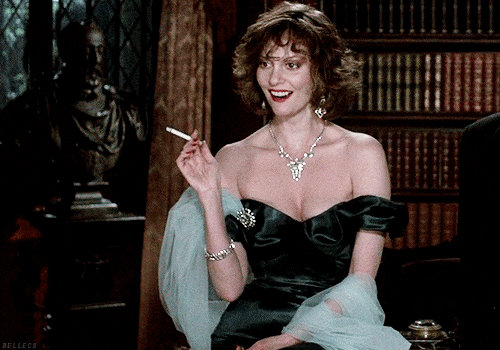
MISS SCARLET
Carrie Fisher was the original Miss Scarlet. Fisher was all set...until she suddenly had to go to rehab. It was the '80s, these things happened -- and in this case, it happened 10 days before shooting was scheduled to begin. Lynn said in a Q and A at San Francisco's Sketchfest that Fisher was "sniffling a lot" when she came in to do a reading and he believed she "had a cold." Lynn's told Buzzfeed, "When I met her at a restaurant, she had actually fallen over a chair, but I had just thought she was shortsighted or something. She sniffed a lot, and she said she had hay fever, which of course I believed."
Most of the production team didn't think Carrie Fisher going to rehab while filming was an issue -- including Carrie Fisher. Fisher told Lynn that she was voluntarily going to attend outpatient rehab and it would be no big deal. " [Fisher] said, 'Oh, yes, they'll let me out during the day and I'll just come back at night,'" Lynn told Buzzfeed. "And I thought, Really? So I asked Debra Hill, and Debra said, 'Yes, that sounds good.' ...Then it was put to Dawn Steel, and she didn't seem to have a problem with it. I didn't know that everyone in Hollywood was snorting cocaine. I was really naive. They weren't doing that in Hampstead, where I lived. Then the insurance company got involved and said, 'Absolutely not. What are you thinking?!' — which surprised everybody but me."
Jon Peters had an ace in the hole: an Oscar nominated ex-wife who he knew was available. With only days before shooting was scheduled to start, the production was up a creek. However, Peters knew his ex-wife Lesley Anne Warren was free. Warren, who had received an Oscar nomination for supporting actress for Victor/Victoria, told Buzzfeed, "When I first heard about [the role], I was actually on vacation with my family...I didn't know anything about the board game. I truly was uninitiated."
Lesley Ann Warren was originally slated to play Mrs. White. Warren believes it all worked out for the best. “I felt like I was more suited to Miss Scarlet anyway," Warren told LBGT News Now. "She’s out of that 1940s period that’s in my wheelhouse. I kind of get it. It was great to play a tough, sardonic, sexy gun moll – and a madam.”
Miss Scarlet's costume was so tight, she couldn't sit down. Warren told Buzzfeed that costume designer Michael Kaplan insisted on the cast wearing historically accurate undergarments, which for her meant a corset. "To rest in that dress was a challenge, so they had slant boards...a diagonal board that one can lean against. It's not uncomfortable, and there are armrests, but you can't sit down all that much. I spent a lot of time there. I didn't play pool."
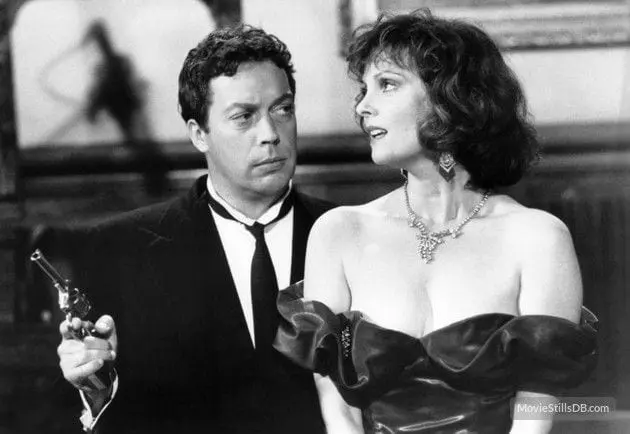
WADSWORTH
The butler died it. Leonard Rossiter, known for his roles in 2001: A Space Odyssey and Oliver! -- was Lynn's choice to play Wadsworth. The two had worked together on Lynn's BBC movie, "A Funny Side of Christmas" and were working on Lynn's West End production of Loot. "One of the funniest men I've ever worked with," Lynn told Buzzfeed. "Unfortunately, he dropped dead in the middle of act one of Loot. Awful."
Rowan Atkinson tried to get the gig but wasn't famous enough. Atkinson was starting to garner attention in England and Lynn wanted to cast him. However, Atkinson's Mr. Bean character hadn't debuted yet. "They'd never heard of him and absolutely weren't interested," Lynn said. "He sent a tape of him doing lots of sketches and funny things. I don't know if they watched it."
Tim Curry was Jonathan Lynn's childhood friend. After John Cleese reportedly turned it down (remember, that is who John Landis always envisioned in the part), Jonathan Lynn turned to an old buddy from boarding school. Curry was making a name for himself as Dr. Frank-N-Furter in The Rocky Horror Picture Show, so he had enough of a following to please the studio. Moreover, Curry credits his classmate as giving him the confidence to pursue acting as a career in the first place.
The role was draining. While the other actors were astonished at how much dialogue Curry had to carry, the actor himself was completely focused on getting through it all -- and it took a toll. “I was exhausted at the end of the movie,” Curry told Buzzfeed. “I actually had a sort of incident of high blood pressure towards the end, when all of the conclusions were happening, because I was running around like a mad person. They took me to the doctor and I had to take pills for a week, my blood pressure was so high. Which was very tiresome.”

MRS. PEACOCK
Eileen Brennan was fresh OUT of rehab. Filming started only six weeks after the Oscar nominee left the Betty Ford treatment center. She was there to overcome a painkiller addiction that occurred after she was seriously injured when she was struck by a car two years prior. Additionally, cast members say the running around between rooms was physically challenging for her. "I had a lot of sympathy for her because she was still struggling," Christopher Lloyd said about Brennan. "She was working very hard to get back on her feet and be able to work again. Not that it showed in her performance at all. But I could see the effort it took for her to get up and do what she was doing. I thought she was absolutely marvelous."
Despite her Oscar nomination a couple of years prior, Jonathan Lynn was unfamiliar with Brennan's work. The writer-director said she'd "reacted extraordinarily favorably" to the role and met with him to discuss it. In the end, he said, he cast her because she was the best person for the part.
Brennan co-starred in Murder by Death. Lynn's comments that he didn't know Brennan or her work is actually super weird. Brennan starred as a femme fatale in Clue's precursor, the Neil Simon murder parody Murder by Death, also a big star ensemble Manor Murder Mystery comedy. In interviews, Lynn said he conscientiously was trying to avoid making a film in the same vein.
Brennan's performance was enhanced by her outfit. In Who Done It: The Clue Documentary, costume designer Michael Kaplan said Brennan had a nervousness about her. "We made her hat, and those little feathers I thought would continue moving after she stopped. So, that jittery performance carries on and is accentuated by the feathered hat."
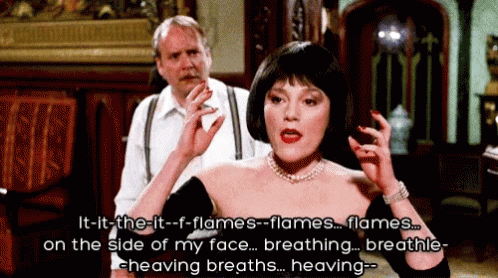
MRS. WHITE
Madeline Kahn inspired Lynn to up his game. The comedy giant of the group was Kahn, who was a Mel Brooks favorite and had been in most, if not all of his films -- including Young Frankenstein and Blazing Saddles. Lynn shared that after Kahn "expressed interest" in playing Mrs. White, he furiously got writing to make the part more worthy of her talent.
Lynn's theater background gave Kahn the confidence he could pull it off. Kahn was the biggest star at the time and she had some worries about working in a noob's first effort. "A first-time director is never a plus,'' she told The New York Times. ''But when I read this script, I felt it had many of the elements of classic farce. And Jonathan had a background in the theater. If the director of this script had made 10 hit films but had never directed classic farce in the theater, it would be a terrible experience.''
The "f-f-flames" speech is the only diversion from the script. Being a theater director, the film production was heavily rehearsed (a rarity) and blocked. The script is tight and punchy, there was no room or time for the actors to be riffing (compare to Caddyshack, a film so heavily improvised, they had a tough time editing together a coherent story). However, Kahn is a comedic genius. "All that was written was, ‘I hated her so much that I wanted to kill her,’ or something like that. But [Kahn] just kind of went into a fugue about hatred. She did it three or four times, and each time was funnier than the last," McKean explained to Buzzfeed. And, Curry said, "“I think Jonathan was very uncertain about it...It was very very funny, and hard not to laugh. Flames!”
In fact, the "f-f-flames" speech actually came about as a compromise. Curry was right, Lynn did have reservations about allowing Kahn to improvise. The Daily Dead quotes Lynn, "She wanted to improv a little and I wanted her to do it my way. So we went ahead and agreed that I would let her do it her way but then she had to do the scene as it was written. Well, of course, what Madeline did was utterly brilliant and hilarious so I didn’t even waste the time having her do it my way. There was no need whatsoever.”
Kahn drew inspiration from her dress. Costume designer Michael Kaplan told Who Done It: The Clue Documentary, "After the first few days of playing the character, she said, 'I don't know what you did to the costume, but I feel like Judy Garland in this costume -- and it's making me do all of these Judy Garland motions I've never thought about or found within myself. I'm possessed by Judy Garland in this costume!"
Some of Kahn's own personality is in Mrs. White. "You see her in this film and it's like life is happening a little too fast, but she's gonna try and catch up with it," McKean told the Clue documentary. "She was kind of like that in real life but it tickled her. She liked that about herself and everyone else adored it about her, too."
THE MALE SUSPECTS: PROFESSOR PLUM, COL. MUSTARD, AND MR. GREEN
Jonathan Lynn took who he could get. While all of these actors are wonderful, Lynn was out of the loop when it came to identifying talent other than childhood friend Curry and comedic icon Madeline Kahn. “I didn’t want any of them from the beginning,” Lynn told The New York Post in 2013. “I was English — I didn’t know who they were.”
Christopher Lloyd was invited to read based on his American TV persona. Lloyd wasn't yet known for Back to the Future - it hadn't come out when he was cast. However, Lynn says he did know him as Reverend Jim from the hit sitcom "Taxi." It really shows the leap Lynn was able to make with Lloyd. Rev. Jim is spaced out driver and "off" after taking too many drugs in the '60s -- completely different from the calm, got it together intellectual Professor Plum.
Lloyd cinched the role the easy way: his reading was the best! Jonathan Lynn told Buzzfeed, "He made me laugh when he came to read. That's the way I select people."
Sketch comedy skills were key. Both Martin Mull and Michael McKean were known for their improv and sketch skills. Mull was known for this offbeat series about a small town TV talk show called "Fernwood 2night," but had memorable roles in film like Teri Garr's handsy boss in Mr. Mom. Michael McKean was most famous for playing Lenny in "Laverne & Shirley" (a character he'd created on the sketch comedy stage) and had made an impression in the mockumentary rockumentary This Is Spinal Tap.
Michael McKean said it was a "silly ass" script -- which was just what he was looking for. If you can make a comedian laugh, you've done your job. McKean told Buzzfeed, "The jokes were making me laugh out loud."
Martin Mull loved the idea of making a movie from the game. "It just seemed like, 'Oh, what a hoot,'" Mull told Buzzfeed. "I remember playing Clue as a child, so I was very sanguine about doing the thing — especially when I found out who else was in it!"
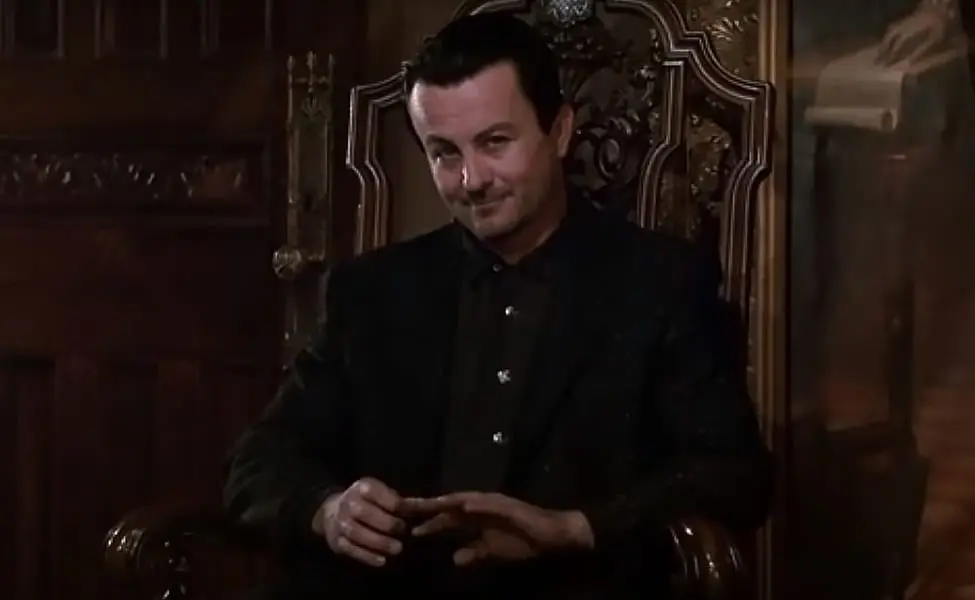
MR. BODDY
Lee Ving was forced on Lynn. The odd man out here is Lee Ving, the lead singer of punk rock band Fear. "He had some big hit record or something. I had imagined somebody rather different, but I said no to every one of the studio's requests, and so finally I thought, 'Well, I'd better say yes to something.'"
Lynda Obst may have been that person behind the "studio request." Ving played the sleazy strip club owner who tries to get Jennifer Beals' character to dance at his club in Flashdance. Obst was the assistant producer on that film.
Ving was singled out because he served as a hint. ScreenRant reports that the singer was picked as a pun that could serve as a clue. The line is...."Mr. Boddy is Lee Ving soon." You doubt? Remember, Professor Plum works for the World Health Organization in association with the United Nations Organization...in your head, you think he works for "UNO WHO."
Is Mr. Boddy's dialogue voice over? So many people believe that Mr. Boddy's lines are actually dubbed, that when you put into Google "Mr. Boddy clue..." Google fills in "dubbed." It might be less about Lee Ving and more about sloppy editing. Movie Mistakes points out there are quite a few audio miscalculation.
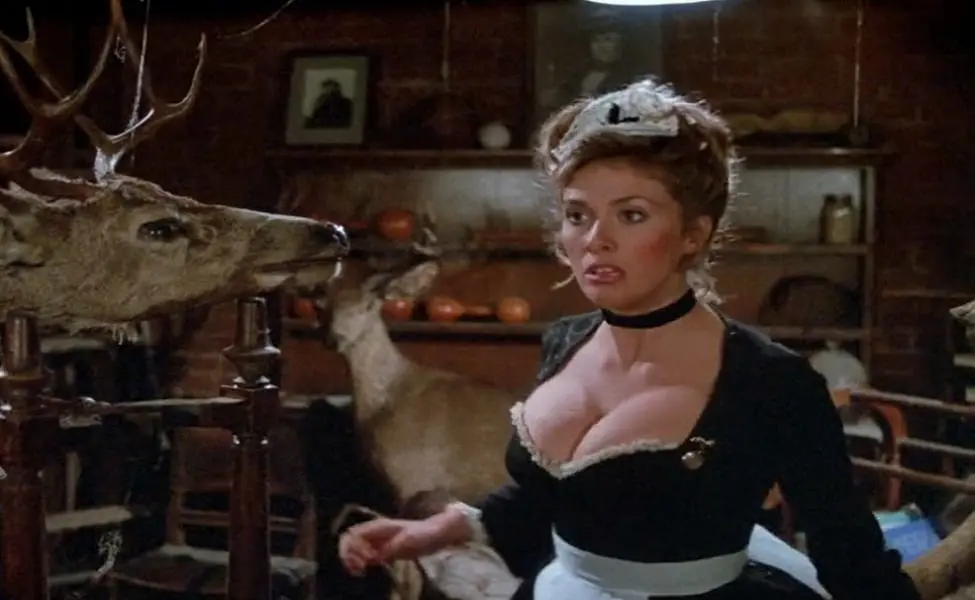
YVETTE
Madonna was considered to play the maid. The singer was best known as a "boy toy" who used her sexuality as a marketing tool, but at the time of casting, Desperately Seeking Susan had not been released yet.
Demi Moore and Jennifer Jason Leigh were considerations. Moore was making her way up the ranks, known best for playing Jackie Templeton on the soap opera "General Hospital" as the love interest for John Stamos' character Blackie. She'd had prominent roles in Blame It On Rio and No Small Affair -- St. Elmo's Fire hadn't hit yet. Jennifer Jason Leigh was a known commodity at this point as the star of Fast Times at Ridgemont High (1982).
Colleen Camp got the job because of her imagination, not her assets. An acting trick is to come to an audition dressed as the part. To Camp's credit, she rented a French maid uniform and wore it to the audition. Camp said the wardrobe helps her find the character and 'informs the role." Jonathan Lynn says that while there was no way not to notice her chest, that's not why she was cast: "I just found her hilarious."
Camp's secret weapon was actually a body movement consultant. Camp says that a friend of a friend worked in body movement and helped her figure out the way Yvette's physicality. "For me, anytime I approach a character, the first thing I want to do is figure out, "How does this person stand?" Camp told Media Mayhem in 2014. "Little things change how you do a part. For instance, Clue. When I did the posture, it was this little subtle thing this [consultant] told me -- she wasn't a French maid...she wasn't a maid! but I said I want to do a certain body language."
That's some French. Camp's accent is courtesy of a couple years of high school French. However, she said it was her intention to make it slightly inauthentic: "I took French in school and I knew it was a pseudo-French, and I wanted to be over the top with a phony French accent."
While known around Hollywood, Camp wasn't yet a household name. The actress had forged friendships with directors whose movies she acted in such as Martha Coolidge (Valley Girl), Peter Bogdanovich (Only When I Laugh), and Francis Ford Coppola (Apocalypse Now), but was in smaller films or small roles at the point she was cast in Clue. She said in a TV interview, she was excited to be in films where audiences would actually see her!
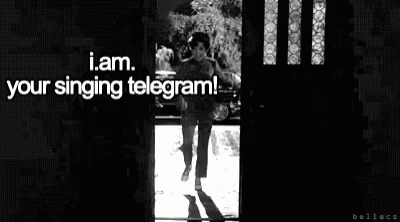
THE SINGING TELEGRAM
The singer had to Go-Go. Jane Wiedlin, the lead guitarist for The Go-Gos, is the surprise tap-dancing guest.
Wait, there's two members of LA's early punk scene? Wiedlin has said the fact that she and Lee Ving are in the film is just a coincidence.
Wiedlin's time on set was super brief. So brief, in fact, she said there was only person related to the film she actually spent time with. She told Retrojunk, "My part in that film was so minor, I never really met anyone, except Tim Curry, who I'd actually already met before."
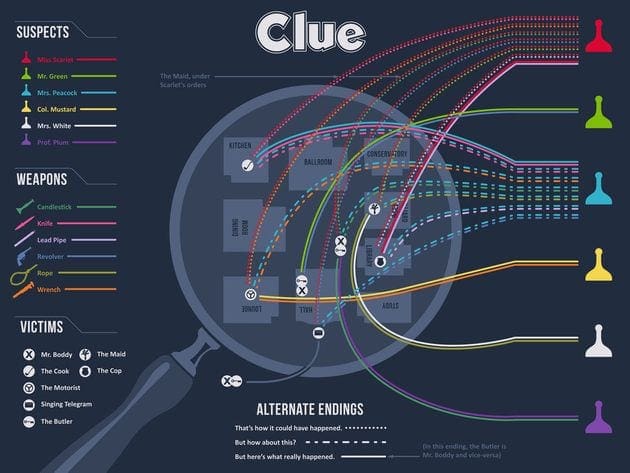
MULTIPLE ENDINGS.
Everyone did it. Multiple endings was an idea conceived by Debra Hill and Lynda Obst from the get go. Obst told us, "We already had that idea at the very beginning," Obst told us in October 2020. "It was in the scripts from the beginning and something we endeavored to do from the very beginning [because] that was the most like the game."
The fourth ending was scrapped. Four endings were filmed, at least partly. In the fourth, Wadsworth is the villain -- but Tim Curry told Buzzfeed Lynn didn't like it. "They thought it was too obvious that the butler did it.”
Everyone dies. Did you notice when Yvette screams, all of the guests run into the room to check on her but Wadsworth is absent? That was to allow for the fourth ending that was scrapped. That's the moment where Wadsworth slips a slow-acting poison into everyone's drinks. His motivation? Tidying up the messy loose ends, just as one would expect from a butler. In this ending, the police chief confronts Wadsworth who runs to make his escape, but is stopped and killed by the guard dogs. However, Michael McKean told Buzzfeed that his memory is that "most of the cast [were] being chased by Dobermans."
Someone DID reconstruct the Fourth Ending. Badass Digest, a site that appears to now be defunct, broke down this mysterious final ending. The only trail of it is that CinemaBlend made reference to it in their own breakdown of the three endings, and gratefully, summed it up, adding in their own commentary -- and note, it makes the film come full circle: "Wadsworth accuses Professor Plum and Mrs. Peacock of working together, probably because he can't get enough of awkwardly calling her "honeybunch". Professor Plum vehemently argues and points the finger at Wadsworth. Everyone is asked to look for the gun. Wadsworth pulls it out. Curve! He killed all six people and poisoned everyone else’s drinks. They will die if they don’t get the antidote. The Kingdom of Heaven/ FBI guy shows up and arrests Wadsworth. He explains the entire night, step by step, except when he goes to the door, he bails and locks everyone inside. The guests escape through the conservatory. Wadsworth drives away in a police car. Unfortunately, there’s a scary dog inside that may or may not have been the one whose shit he stepped in."
An original idea creates a challenge to pull off. "It was a great hook, we didn’t know it was logistically possible because it involved getting different films to the theaters. If you were in Altoona, Pa., and there were two theaters, you’d have to have two different films in two different theaters," Obst told us, explaining why it was more difficult than anticipated: "Production had to work with distribution, which they really didn’t know how to do. Everyone thought it was a great idea, it just turned out to be incredibly hard."
In reality, the multiple endings was the killer. It turns out that the clever marketing idea didn't encourage moviegoers to buy tickets and see all the endings. Rather, it turned off moviegoers. "If the filmmakers didn’t know how they wanted to end the film, why would [the audience] go and see it,” Lynn told The New York Post. “I constructed a story that you could find three logical explanations for, and that backfired badly.”
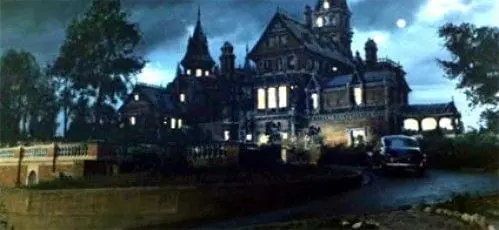
THE MANSION
Hill House carried double meaning. The mansion was named after Shirley Jackson 1959's horror novella, "The Haunting of Hill House," recognized as "the definitive haunted house story." However, it was also named for the film's producer, the one who conceived of Clue becoming a movie, and particularly well known at the time for writing the horror film Halloween: Debra Hill.
The floors matched the game. The parquet floors in the ballroom were designed to match the ones in the ballroom of the board game, according to Fast-Rewind.
The furniture was very presidential. Set decoration was by Thomas L. Roysden. Fandom reports, "To decorate the interior sets, authentic 18th and 19th century furnishings were rented from private collectors, including the estate of Theodore Roosevelt."
The closest thing to Hill House was in Pasadena. The exterior shots were done, according to the production notes, at 160 S. San Rafael in Pasadena. That includes the driveway and the "country lane" shots. The distant shots of the grand estate, though, are likely artistic creations, according to ArtofMurder.com. The site also reports that while the Pasadena mansion was undergoing renovations, a fire began and it burned down.
The "house" alone cost $1 million. Almost all of Clue was shot on a set that was made to look like a mansion. The budget to make the movie was $8 million -- so the $1 million price to create the mansion was incredibly steep. Lynn told The Daily Dead, "That was a hell of a lot of money to spend on a set in 1984!"
Appearance is only part of the design. In 1984, that $1 million could've been used to actually build a magnificent home. “It was an enormous set. The whole of the inside of the house was built on Stage 16 at Paramount, with the exception of the ballroom, which was an actual location.," Lynn said, but explains why it was preferable to shooting at an actual mansion. "The set also included a part of the exterior, where the cars pull up in the rain and outside the front door too. That set required such a huge amount of lighting and then we’d also have to go through staging each scene with so many people in it, so production was always a slightly slower business than it probably should have been. But the amazing sets were all due to John Lloyd and his team of designers; I thought they did an amazing job. It was a work of art.”
Hill House became the Carlton Hotel. All that money wasn't thrown out the window. After the shoot completed, the nighttime soap Dynasty bought the set and transformed it into the Denver hotel.
The Billiard Room became the hangout for the cast in between shots. "Every time we'd have even five to ten minutes down," Martin Mull said to Buzzfeed, "all the guys, and the girls too, would end up in there and just banter around the pool table."
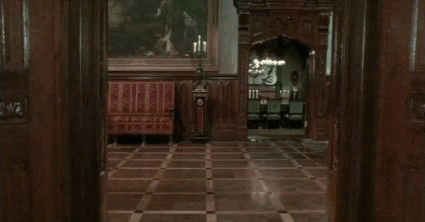
FILMING
Jonathan Lynn had the entire cast gather to watch His Girl Friday-- and now thinks that was a mistake. The Cary Grant-Rosalind Russell classic was the inspiration for film's zippy pace and patter. Lynn said at a more recent Q and A that he instructed the cast, "This is the pace that we need to be at." Warren told Buzzfeed, "He wanted us all to have that cadence, that very clipped, quick delivery on our lines." However, Lynn now regrets the hurriedness because jokes get lost in the shuffle, saying he can see now that it's "just a bit too fast."
The cast was elated to be working with one another. The actors have almost all separately reflected on what an amazing experience it was to work on the film, and to work together. Lloyd was psyched to be a part of the stacked cast. "It was a hardcore group of real actors who had a lot of work behind them. I felt like kind of a beginner. I was just hoping I could hold up my part well enough to blend in."
"Herding puppies." It's rare that so many actors are on a set for so long at the same time. Think about Bill & Ted's Excellent Adventure: giant cast, but rarely are they all together at once. The cast created a friendly bond. Mull said, "We were always all together, and it just made it so much more fun." Warren noted, "I felt so deeply sorry for Jonathan because we were in hysterics the whole time...It was like trying to herd a bunch of puppies."
While filming the whodunit, none of the cast knew who did it. The film was shot in order and the cast was kept in the dark about who the killer(s) were. "We pretty much shot in sequence because we’re all in one outfit and we’re on one stage so there’s no reason to do day five before day one. You could do one, two, three, four. We never knew, during the course of the shooting, who the killer was," Martin Mull said at the press event for the Clue-themed episode of Psych. "And then we didn’t know at all until we were done with the body of the show, we didn’t know there were gonna be four endings." Lesley Anne Warren was there, too, and backed that up.
McKean was a metaphorical film clapper. With so much zaniness and a cast who loved to crack each other up, keeping a straight face was a Herculean effort. However, Mull says McKean would reset the cast at the beginning of every take. "We were laughing so much, one thing that has stayed indelible in my mind is before every take of every scene, Michael McKean would say to everyone in the cast, 'Something terrible has happened here,' to try to bring us back to the reality of where we were," Mull said. "It got to be quite a funny little catchphrase."
The crystal chandelier falling had everyone freaked out. Lynn took over directing duties from John Landis, who was currently embroiled in a tragic scandal where actors died on his set during filming. Lynn worried that if anyone was injured on his set, it could do serious damage to Landis' career. "The last thing in the world that could have happened on this picture with him as the producer could have been an accident on the set, so I was being very, very cautious," Lynn said. As a result, Lynn said the chandelier drop falls flat. "It should have only just missed them, and it misses them by quite a bit, and that was me not having the nerve or the confidence to trust the stunt coordinator."
The prop master pranked Martin Mull. Apparently, not all on the crew was aware of Lynn's nervousness about the chandelier, which was intended to look like it was going to hit Col. Mustard. Mull recalled that the prop master gave him a good scare. "He came up to me, right before we were going to do the thing, acting quite a bit tipsy, and said, 'Gah, hope to guh 'is goes ah right.' Scared the shit out of me. I thought, Oh no. No, no. This is no way to go out," Mull said. " I guess, [he can play] a very, very, very good drunk."
The shoot lasted three and a half months. Think about wearing the same clothes every day for three and a half months. Think about poor Lesley Anne Warren wearing the same tight corset that she could barely sit in every day for three and a half months. But, that's not the memories the cast carries with them. "There’s something that happens to just your brain ... that all of us were in one set for 13 weeks. It’s probably the same kind of mentality that happens when people are trapped in an elevator, you know, for eight hours and something happens to your sense of logic and your ability to communicate," Mull said to MyTakeonTV.com. "So it just blew out down on Clue.
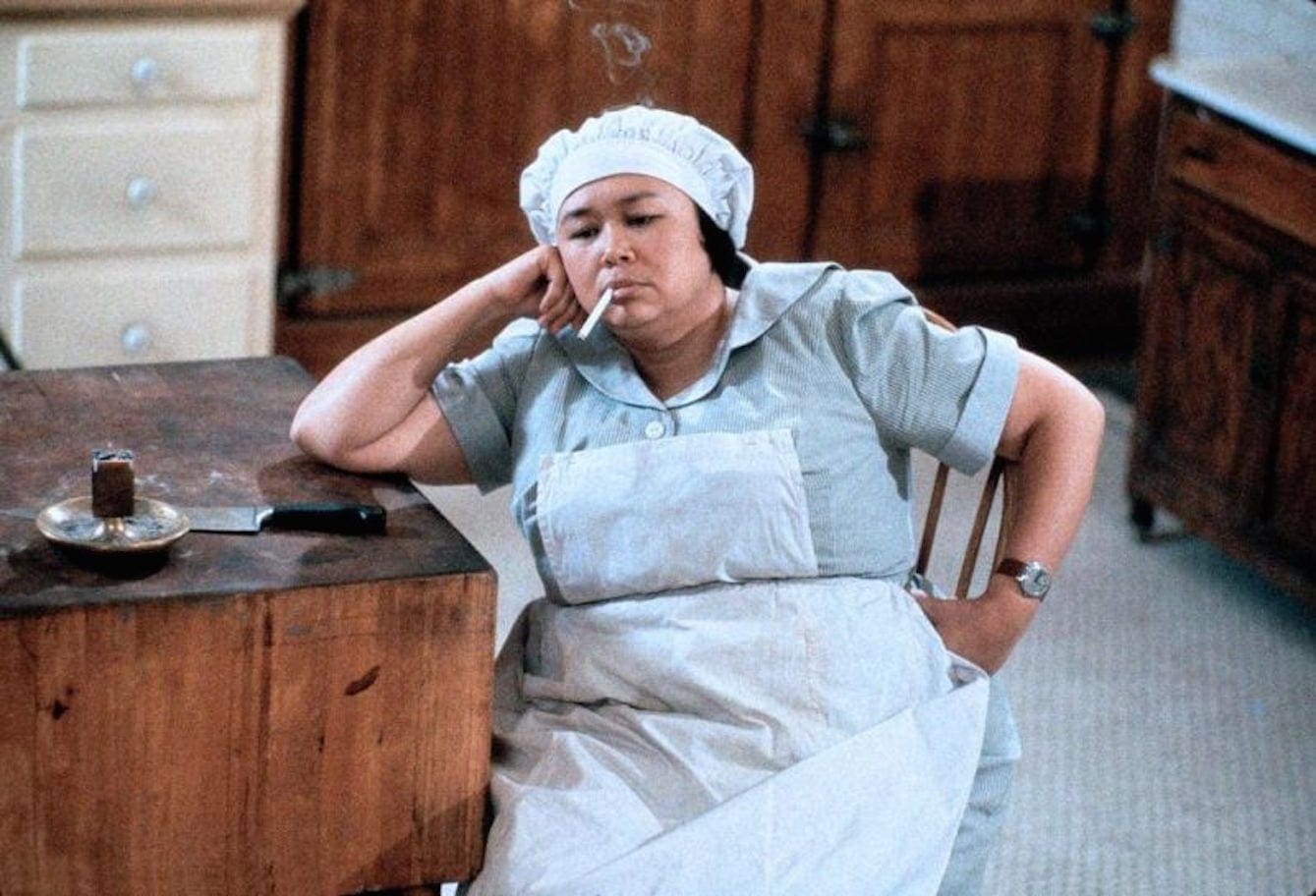
FUN FACTS AND IMPORTANT NOTATIONS
John Landis was working on Clue in the middle of the Twilight Zone tragedy. Landis was brought on to the Clue production at the beginning of 1982. On July 23, 1982, Landis was directing a scene in his portion of The Twilight Zone Movie involving a helicopter transporting three actors: Vic Morrow and children Myca Dinh Le (age 7) and Renee Shin-Ye (age 6). The helicopter crashed and killed all three of the actors. It was later revealed that Landis made reckless decisions, flying the helicopter too low to explosives, keeping it a secret that he was filming the children at night, and lying to the children's parents about the unsafe conditions.
The cook was famous. too. While much gets made about Go-Go Jane Wiedlin in her singing telegram appearance, not much noise is made about the cook, who doesn't get to say a single line. But, Kellye Nakahara was a well known face. She was a series regular on M*A*S*H, the most popular TV series of the 1970s and early 1980s.
Marketing materials made a promise it couldn't deliver. The advertising tagline read, "The mystery we dare you to solve." But, of course, with the public knowing there were mutliple endings, clearly, there was no way to "solve"
Jonathan Lynn's 11-year-old got screen credit. As Lynn was working so far from home, he brought his family with him to Los Angeles. His son, Teddy, joined his father on set. "He was a great kid, wanting to help, and he rode around the Paramount lot on a bike all day, doing useful errands for the producer Debra Hill and others," Lynn told Stage Buddy. "When we finished the film, Debra gave him a credit as Production Assistant, because, she said, 'he was so much more helpful than any of the other PAs.'"
The 1950s were a popular era for cinema. Lynn has stated he set the film in the 1950s because he could connect the idea of showing up with code names with the McCarthy era, where people could be blacklisted if they were a "red." However, the latter part of the '70s and into the '80 were indulging in a '50s renaissance. Happy Days and Laverne & Shirley were two of the biggest sitcoms, both sent in the 1950s. In film, Grease in 1978, Diner (1982), to Back to the Future (1985) also starring Christopher Lloyd, Stand by Me (1986), Hoosiers (1986), Dead Poets Society (1989).
We will likely never see the infamous Fourth Ending. In 2012, Lynn was asked by Abnormal Use about the mysterious fourth ending, which he'd always been elusive about. Lynn confirmed that he shot it, and then he scrapped it-- and where the footage went is a mystery: "I have no idea. I cut it out because it really wasn’t very good. I looked at it, and I thought, “No, no, no, we’ve got to get rid of that.”
For Lynn, his work has come full circle. Jonathan Lynn's break out piece of work was "Yes, Minister" -- that's what got Hollywood's attention and has stayed relevant in the UK over the decades. He created a version for theater, and for the Los Angeles production at the Geffen theater, cast McKean as the lead. Lynn said, "I watched him over the years and went to New York and saw him in Gore Vidal's 'The Best Man.' He was awfully good in it," Lynn recalled. "It occurred to me he might be a really good Jim Hacker. I expected him to bring a great deal to the role, and that's what he's doing."
Jonathan Lynn hired two of the actors after they were horrific car accidents. Eileen Brennan and Michael McKean both were hit by cars and had to overcome major injuries. Brennan's occurred Oct. 27, 1982 as she was leaving a restaurant where she'd dined with her Private Benjamin co-star and friend, Goldie Hawn, in Venice. Reports are that she stepped into the street while turning to say goodbye to Hawn, not seeing the oncoming car. She suffered two broken legs, a fragmented jaw, broken bones on the entire left side of her face and a broken nose, and her eyeball was wrenched from its socket. Her role in Clue was her first film after healing from the accident and the subsequent addiction to painkillers. McKean was in New York doing work on Broadway when an out-of-control car hit him while he was walking on a sidewalk at 86th Street and Broadway on the Upper West Side. It resulted in facial lacerations and a broken leg, which had him residing in the hospital for 21 1/2 weeks, he said. Less than 6 months later, he was working on a TV series, and then went to work for Lynn in "Yes, Minister."
REVIEWS, REACTION & REEVALUATION
Clue was ahead of its time. While moviegoers and critics alike delight in the comedic whodunit, it was a different story in 1985. The three endings was a real issue.
Janet Maslin of the New York Times actually calls out Lynn as a misogynist. Maslin wasn't thrilled with the low-brow humor. She points out the "dog poop jokes," the "stupid double-entendres," and "the repeated and conspicuous ogling of Yvette." She wrote, "These touches, aside from giving the film a vulgarity it doesn't need, help to make it mildly unsuitable for the young audiences that might like it best. ''Clue'' is substantially smuttier than its PG rating would indicate."
Roger Ebert gave a note that the studio followed. While he panned the film, giving it two stars and saying "fun is in short supply," he made a wise suggestion: "Since this movie is so short anyway (88 minutes), why doesn't the studio abandon the ridiculous multiple-ending scheme and show all three endings at every theater? It would be more fun that way."
Gene Siskel believed it shouldn't have three endings, but three middles. He wrote in the Chicago Tribune that changing the entire body of the film would improve it. “Clue offers a few big laughs early on followed by a lot of characters running around on a treadmill to nowhere.”
The Los Angeles Times called it "tedious." Kevin Thomas wrote that it was equally uninteresting as a comedy as it was a mystery. "The more you struggle to keep track of the constantly multiplying plot developments, the harder it gets to care who did it."
At the box office, the film was as dead as the guests of the dinner party. The opening weekend box office was just over $2 million. All in during its theatrical run, it grossed $14.6 million. The budget (including P&A) was $15 million.
Three endings is a bad look for a filmmaker. In hindsight, Lynn realizes the problem was obvious. “I don't think anyone's ever done it before or since and there's a very good reason for that- because it didn’t work. I think it's one of the reasons why we didn't do well when we opened; I feel like the public didn't know which version to go and see, so they thought, 'Well, I can't decide, so I'll go see something else,'" Lynn told The Daily Dead. "I think also the problem was that, in a sense, the point of every film is in the ending and if the filmmakers can't decide how to end a film, that tends to put the audience off."
The head slap of not going with your gut. Lynn said at the time, no one realized how off-putting three endings would be. "It was conceived by the studio as a way to make the audience go several times but nobody thought that it might have the opposite effect, and I think it did. In fact, shortly before the film was finished, the last day or two before we had to make the final print, I was of two minds about whether I should change the ending and put all three endings together as they are now on the home versions. I foolishly went along with the original idea. But it was wrong. It was wrong for one important reason, which is that the cleverness of the story is only apparent if you see all three endings and that’s how we should have done it all along."
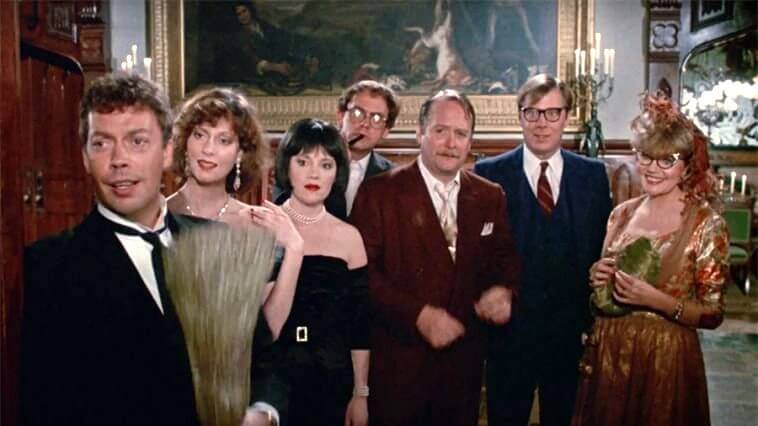
FROM FLOP TO FAN FAVORITE
Jonathan Lynn's film career was a victim of the negative response. At first, it was curtains for Lynn in Hollywood. "It came out and overnight I went from being a hot director to a freezing one," Lynn told Stage Buddy in 2015. "It seemed to be that the film would follow me around like a lame puppy, and I'd never make another."
Cable's growth gave Clue a different ending. WIth endless hours of time to fill, cable channels began running the murder mystery -- and latchkey kids were watching. "It started showing on TV in the afternoons," Lynn told Stage Buddy. "Kids loved it. And as they grew up they discovered they still love it!"
Like a good wine, time seemed to have improved Clue's flavor. “What's rather incredible about Clue though is that it has gotten a bigger and bigger audience as the years have gone by," Lynn told The Daily Dead. "I get more fan mail and email and social media contact about Clue than about anything I've ever done. It's become enormously popular with people and how many films can you say that about? Not many, which proves just how special Clue really was and continues to be, even now.”
Analysis: Clue succeeds today for all the reasons it failed in 1985. When you read the reviews of the film, the critics weren't necessarily wrong -- they just had high expectations based on the era. However, in this current age, comedic murder mysteries are hard to come by. Comedies aren't so jokey -- and they're definitely not one liner after one liner. And the multiple endings, even though decades old, comes off as fresh and original. It's a total delight. And, of course, we now recognize the cast as comedic greats -- especially Madeline Kahn, who is no longer with us. While, perhaps, the film will always remain in the rank of the 2-star movie, we love it because, as they said in the 1950s, it's a hoot.
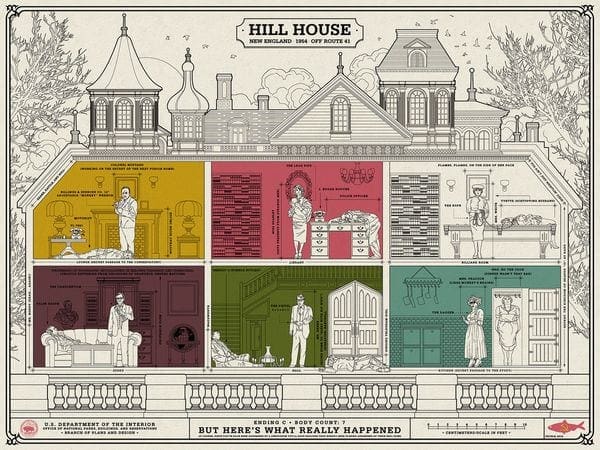
LEGACY
Knives Out. Clue was one of Rian Johnson's inspirations in creating his comedic mystery. In fact, in the film, its said that the guy who winds up dead, Harlan Thrombey, "practically lives in a Clue board."
It's now a play. Jonathan Lynn himself adapted his screenplay into a stage production that became available in 2017. Since Lynn was originally a playwright and theater director, and the film takes place in one location (albeit several rooms), it certainly had the makings of a play.
Psych. In 2012, the popular, offbeat USA series about detectives had a Clue-themed show to mark its 100th episode. There was a mystery to solve at a dinner party at a mansion, and among the guests were Lesly Anne Warren, Martin Mull, and Christopher Lloyd. Entertainment Weekly described it: "The episode, titled “100 Clues,” features a slew of Clue references – including Shawn’s take on the one-plus-two-plus-one-plus-one banter – and also takes on the device that generated a lot of the film’s buzz upon its release: multiple endings. And this time, the audience has a say in how it ends. Fans can vote for one of five suspects online or via Twitter. "
Ryan Reynolds plans a reboot. In 2018, in what would be the last year of 20th Century Fox (RIP), the studio made a three-picture deal with their cash cow Ryan Reynolds. His first project announcement was to make a new version of Clue, written by his Deadpool scribes Rhett Reese and Paul Wernick and directed by Jason Bateman. Due to time conflicts with Bateman's hit Netflix series Ozark, he backed out. Director Jason Bobin, known for rebooting The Muppets and Dora and The Lost City of Gold was hired to take over.
Fans are still trying to solve the mystery. Many writers have tried to determine which of the endings was "the real one." While Looper believes Ending C "They All Did It" is correct. Births Movie Death goes into detail about Ending D, which was cut. Polygon came to the conclusion that Ending A where Miss Scarlet and Yvette team up is the only one that works.
Clue led Hill and Obst to become the first-ever female production team. Producing powerhouse Dawn Steel felt Hill and Obst would make for the ultimate production partners -- and ensured it happened. "Dawn Steel said you two should be producers: Lynda you know development, and Debra, you know production, you should be partners. And we said, you know what, you’re absolutely right! Dawn blessed it and we agreed. Plus we’d had such a good time on Clue," Obst told us, explaining that Steel offered them a deal at Paramount Pictures. "It’s one thing to say, “this is a good idea,” and another to give you an offer with the money. We [Lynda and Debra] also wanted the same thing: we both wanted a big studio deal. She had been an indie and I had been an executive — we wanted to be the female Simpson-Bruckheimer…without the intended naughtiness, if you know what I mean."
Jonathan Lynn's film career recovered with My Cousin Vinny. He stated in an interview that the way he was frozen out of Hollywood following Clue's chilly reception, but it made him more determined to get back in the game. He directed the (very British) Eric Idle-Robbie Coultrane comedy Nuns on the Run (1990) and then landed My Cousin Vinny, which was a huge hit and nabbed Marisa Tomei an Academy Award. Any career missteps were then forgotten.
Clue art is a whole thing. For a box office flop, Clue has served as artistic inspiration for many. Los Angeles' Gallery 88 even had a Clue themed art exhibit that got the attention of The Huffington Post.
Soundtrack
John Morris composed the score, which is complimented by two songs that remind the viewer the film is set in 1954.
Director: Jonathan Lynn
Screenwriter: Jonathan Lynn
Release date: Dec. 13, 1985
Rating: PG
Opening weekend rank: #6 (#1 was Rocky IV, followed by The Jewel of the Nile, Spies Like Us, White Nights, & Santa Clause: The Movie)
Opening Weekend Box Office: $2 million
Lifetime Gross: $14.6 million
Budget: $15 million
Production Company: The Guber-Peters Group
Distributor: Paramount Pictures



